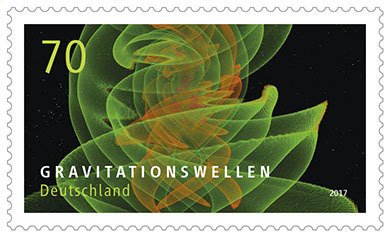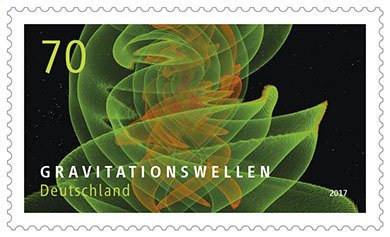Post a Gravitational Wave!
Numerical-relativity simulation performed at the Max Planck Institute for Gravitational Physics on a new Deutsche Post stamp
This year’s Nobel Prize in Physics was awarded for the LIGO observation of gravitational waves from colliding black holes. Very soon everyone will be able to send the image of the prize-winning discovery by letter. As the Federal Ministry of Finance announced yesterday, a 70 cent stamp featuring Einstein’s space-time ripples from the collision of two black holes will be issued on December 7th. Members of the “Astrophysical and Cosmological Relativity” division led by Prof. Alessandra Buonanno at the Max Planck Institute for Gravitational Physics in Potsdam performed the numerical-relativity simulation of this outstanding discovery, whose image appears on the stamp.
“I am very pleased that a stamp will soon honor the first detection of gravitational waves. The image on the stamp represents gravitational waves emitted by the two orbiting black holes observed by the LIGO detectors in September 2015,” says Alessandra Buonanno. “Gravitational-wave astronomy has really boomed these days: the Virgo detector has recently joined the LIGO network and has also observed gravitational waves. Besides black holes, we have also observed neutron stars, and the Nobel Prize this year was awarded to the discovery of gravitational waves by LIGO. The stamp is launched at just the right time and it will certainly contribute to increase the popularity of gravitational-wave astronomy."
Dr. Serguei Ossokine, postdoc in Buonanno’s division at the Max Planck Institute for Gravitational Physics run the numerical relativity simulation. “I started working at the Max Planck Institute for Gravitational Physics on September 15, 2015 and almost immediately after I started, Professor Buonanno revealed to me that there has been a possible gravitational-wave detection,” he says. “So, essentially at my first day at work, I was asked to produce a numerical-relativity waveform that would reproduce the parameters of the first detection of gravitational waves with LIGO.”

The Ministry did not announce whether or not letters equipped with the new gravitational wave stamp will be transported at the speed of light.
Accurate modeling of gravitational waves has paved the way for observing and interpreting merging black holes and neutron stars
Binary systems composed of black holes and/or neutron stars are the most exciting sources for gravitational-wave detectors. The successful observation of these sources has required detailed knowledge of the expected signals. Researchers in the “Astrophysical and Cosmological Relativity” division at the AEI in Potsdam have developed highly accurate models of gravitational waves emitted by binary black holes and binary neutron stars as they orbit each other and eventually merge. These waveform models have been implemented and are employed in the continuing search for coalescing binary systems with the LIGO and Virgo detectors, and are crucial to detect the signals. Scientists in the division also use the same waveform models to infer the properties of the astrophysical sources, test Einstein’s theory of General Relativity, and probe fundamental physics.
Some members of the “Astrophysical and Cosmological Relativity” division are part of the Simulating eXtreme Spacetimes collaboration which has developed the numerical-relativity code used for the binary black-hole simulations. The visualization of the two colliding black holes was performed at Airborne Hydro Mapping Software GmbH, a company that was co-founded by Werner Benger, a former postdoc at the Max Planck Institute for Gravitational Physics in Potsdam and the Zuse Institute in Berlin.
